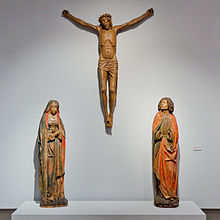Crucifixion group from Großkönigsdorf
The (former) crucifixion group from Großkönigsdorf (also: Budapest-Großkönigsdorfer Gruppe ) is a sculptural group made of limewood, dated around 1480/90, depicting Christ on the cross with Mary and the evangelist Johannes . The group is attributed to the workshop of the Cologne woodcarver Meister Tilman and was located in the St. Sebastianuskirche in Frechen-Großkönigsdorf until at least 1912 . Originally the group comes from the monastery church of the Benedictine nuns in Königsdorf monastery, which was laid down after 1802 .
history
The crucifixion group stood in a wall niche on the outside of the former Benedictine monastery Großkönigsdorf. In 1897 Paul Clemen described it as "originally polychromed, but unfortunately completely smeared". In 1912 a photo shows the group in context; how the separation of the characters came about is unclear. Until they were rediscovered in Budapest in 1989, the accompanying figures were considered lost.
It is clear that the Budapest Museum of Fine Arts bought the two standing figures in 1916 from the Munich art dealer Julius Drey; the crucifix remained in Großkönigsdorf. Until 1981 it was in the aforementioned niche - supplemented by two other accompanying figures. During the Second World War it was damaged by shrapnel and in 1981 it was finally relocated to the new Hildebold Church
The group was shown together again temporarily (November 2011 to February 2012) in the exhibition "Splendor and Greatness of the Middle Ages" in the Museum Schnütgen in Cologne .
description
The lime wood figures of the mourning Maria and Johannes are slightly larger than life (Maria: 1.82 meters, Johannes: 1.86 meters) and are hollow on the inside. Both sculptures are equipped with long, colored robes. While Mary is standing to the left of the crucifix with her hands folded, palms bent to the body and bowed head, the figure of St. John to the right turns her head with heavily wavy hair up to the crucified Christ. His forearms are bent, the palms of the hands pointed upwards at a slight angle. The hands of the sculpture were still there in 1912 - as can be proven by a photograph - but disappeared when it was sold to Budapest in 1916. Apart from that, the figures are completely preserved. Except for the faces, they are polychrome with parts of the original frame , which were discovered during the restoration in 1977 and 1982.
The crucifix is 2.10 meters high and 1.70 meters wide with outstretched arms. The figure of Christ is completely preserved; As with most of the crucifixes from Tilman's workshop, the head is tilted slightly to the right, the eyes firmly closed and the mouth slightly open. The body is strongly drawn in under the pronounced chest, the legs slightly bent. The loincloth is pushed through the right thigh and covers the right leg up to the calf. Pigments from an older color version do not appear to be present, the figure is painted completely brown.
Assignment to Tilman's workshop and dating
The Cologne workshop of master Tilman , whose work is characterized by a Dutch influence, was assigned numerous wooden sculptures based on style comparisons, including the Großkönigsdorf group. The artist's name has been known since 1977; Gunther Fabian identified him as Tilman Heysacker (called Krayndunck), a student of the Dutch sculptor Meister Arnt . It is documented in Cologne from 1487 to 1515.
The art historian Holger Kempgens assumed that the figures were dated around 1493 due to a cross altar consecration in the same year; he supported his thesis by comparing styles with other works by Tilman, which can be dated more precisely.
The Hungarian author Miriam Szőcz suggested a later date in 2011 due to similarities with the Von Carben master - a former student of Tilman - since the two sculptors had worked together at the beginning of the 16th century.
literature
- Holger Kempkens: Lost sculptures found in the Budapest Museum. in: Denkmalpflege im Rheinland, Volume 4, December 1990, pp. 38–40
- Miriam Szöcs: Christ on the cross with Mary and John the Evangelist (formerly crucifixion group). In: Dagmar Täube and Miriam Verena Fleck (eds.): Splendor and size of the Middle Ages. Cologne masterpieces from major collections around the world , pp. 370–372, ISBN 978-3-7774-4531-1
Individual evidence
- ^ Heinz Wolter: History of the Benedictine convent Königsdorf, Pulheim, Association for History and Local History 1995
- ^ Paul Clemen : The art monuments of the Rhine province. Volume 4, Part 1: District of Cologne. Duesseldorf: Schwann 1897, p. 143
- ^ A b Holger Kempkens: Lost sculptures found in the Budapest Museum. in: Denkmalpflege im Rheinland, Volume 4, December 1990, pp. 38–40
- ^ Frank Kretzschmar: Churches and places of worship in the Rhein-Erft district , Cologne 2005
- ^ Gunter Fabian: Crucifix by Tilman. New finds on the work and the person of a Cologne carver. In: Kölner Domblatt . Yearbook of the Central Cathedral Building Association , 42nd volume, 1977 pp. 267-276
- ↑ Miriam Szöcs in the splendor and greatness of the Middle Ages, p. 372
